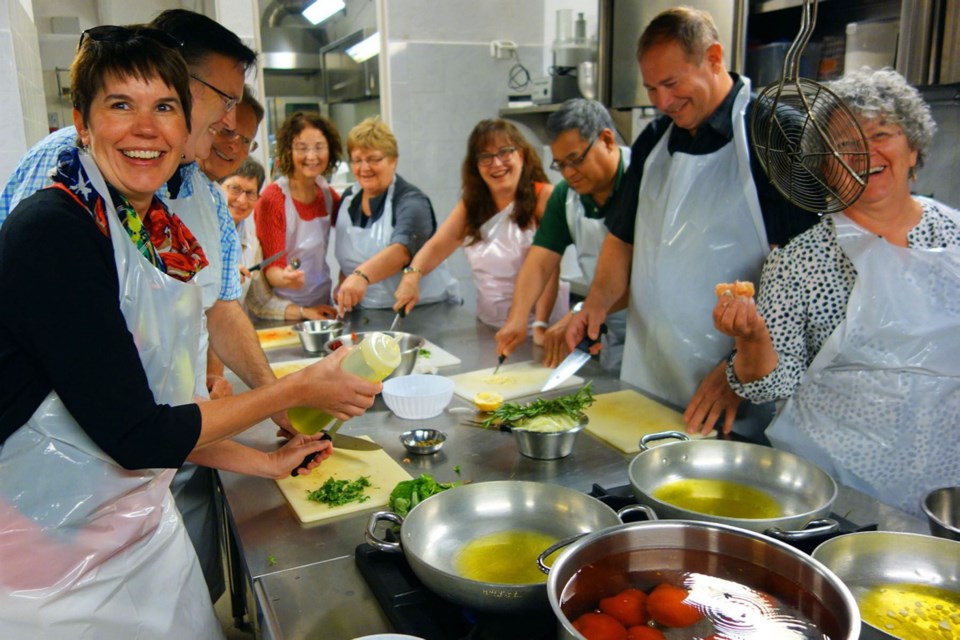Sampling Italian cuisine is sightseeing for your palate. The tour plan: Start with fresh ingredients and talented cooks, take in a city’s personality, and seek out a happy dining crowd.
Experiencing Italy’s cafés, cuisine, and wines is a joy, and as the capital of Tuscany, Florence offers a particularly satisfying spread. Tuscan cuisine is hearty and simple farmer’s food: grilled meats, high-quality seasonal vegetables, fresh herbs, prized olive oil and rustic bread.
Tuscan riboleta combines these ingredients into a savory bean-and-bread soup. If a dish’s name ends with “alla toscana” or “alla fiorentina,” that means it’s cooked in the Tuscan or Florentine style — usually a preparation highlighting local products.
Restaurant competition in Florence is fierce, so it’s easy to find delicious Tuscan specialties at fair prices — even in the most touristy zones.
But for the most authentic ambience and better-quality meals, I like to hike across the Arno River to the quiet Oltrarno neighbourhood. This is where I find the tastiest bistecca alla Fiorentina — thick T-bone steak, generally grilled very rare and lightly seasoned. The best (and most expensive) is from the white Chianina breed of cattle you’ll see grazing throughout Tuscany.
But dining out is only one option for foodies. The heart of the food scene in Florence is the trendy Industrial Age, steel-and-glass Mercato Centrale (Central Market). Along with all the must-see museums, this market is one of the great sights in Florence.
The ground floor is a thriving edible wonderland of vendors selling meat, fish, produce and other staples to a mostly local clientele. And the upstairs is a bustling food court open late into the evening.
I come here to gather fresh mozzarella cheese, olives, fruit, and crunchy bread for a casual picnic. But these days, picnickers like me need to be discreet — Florence now bans eating on public sidewalks and doorsteps in its historic centre (and violators risk a hefty fine).
At the market’s tripe stand, it’s easy to see that locals eat just about every bit of the cow…and some bits unique to the bull, too. Tourists might find it hard to stomach, but Florentines’ favourite quick lunch is a panino (sandwich) of trippa or lampredotto — the lining from the second and fourth stomach of a cow, respectively — slow-boiled to tender perfection.
Offal sandwiches originated as an affordable source of protein for working-class Florentines. While on lunch breaks from chipping trapped statues out of blocks of marble, Michelangelo would swing by a Florentine market and dig into a bun stuffed with stewed organs.
The city’s longstanding love affair with this sandwich nearly faded away a few years back, but the recent worldwide trend for “nose-to-tail” eating has kicked off a renaissance of food carts selling this local favourite.
Most carts also offer bollito (stewed beef) and the always delicious — and easier to stomach — porchetta (roast pork with herbs). No matter what you order, watch closely as the food-cart owner pulls the lid off a gently simmering pot, forks out some tender meat, and — if you’re lucky — dips the bun in the broth before topping it with spicy and tangy sauces. But if you have the guts … give trippa a try. It’s offal.
Cooking classes are an ideal way to learn a thing or two about this region’s prodigious culinary tradition. Classes in Florence range from multiday or multiweek courses for more serious chefs, to two- or three-hour crash courses for tourists.
These are some of my favourite activities in Tuscany, combining a unique Italian experience (learning to cook, say, pasta from scratch) with a satisfying meal, in just a few hours.
In my experience, the best casual cooking classes are taught in a real kitchen environment (rather than a stuffy classroom or “show” kitchen) and have a spirit of fun and collaboration. Smaller groups allow more personal interaction and hands-on activity. After a couple of hours cooking, everyone sits down to a hard-earned (if not always flawlessly executed) meal. They’ll usually send you on your way with the recipes you prepared that day.
I cap nearly every Italian meal with a gelato-fueled stroll. Italy’s most flavourful ice cream-perhaps the world’s best — is in Florence. I stay away from places with heaping mounds of brightly (artificially) coloured gelato and instead look for covered metal tins with muted-hued gelato that’s more likely to be homemade. Seasonal flavours are also a good sign. I find the key to gelato appreciation is sampling liberally and choosing flavours that complement each other, such as caffè (coffee) and cioccolato (chocolate).
Florence offers a wide array of foodie activities and Tuscan delicacies beyond the usual Italian pizza and pasta fare — be brave and dive in. Consider these edible experiences part of your sightseeing duty. Buon appetito!
Rick Steves (ricksteves.com) writes European travel guidebooks and hosts travel shows on public television and public radio. Email him at rick@ricksteves.com and follow his blog on Facebook.



